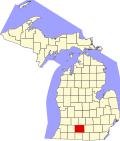Governor's Mansion | |
 | |
 Interactive map of Governor's Mansion | |
| Location | 621 S. Marshall Ave., Marshall, Michigan |
|---|---|
| Coordinates | 42°15′54″N84°57′16″W / 42.26500°N 84.95444°W |
| Area | 1 acre (0.40 ha) |
| Built | 1839 |
| Architectural style | Greek Revival |
| NRHP reference No. | 75000939 [1] |
| Added to NRHP | January 8, 1975 |
The Governor's Mansion at 621 S. Marshall Ave. in Marshall, Michigan is a historic house built in 1839 with elements of Greek Revival architecture. It is also known as Governor's Mansion Museum. It was listed on the National Register of Historic Places in 1975. [1] In 2017, the house is a museum owned and operated by the Mary Marshall Chapter of Daughters of the American Revolution. [2]


